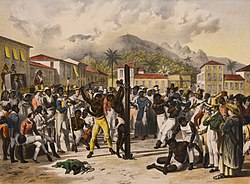Satavia: Difference between revisions
Jump to navigation
Jump to search
No edit summary |
No edit summary |
||
| Line 66: | Line 66: | ||
==Etymology== | ==Etymology== | ||
==History (Under Re-Construction)== | ==History (Under Re-Construction)== | ||
===Pre-Historic=== | ===Pre-Historic=== | ||
| Line 76: | Line 74: | ||
===Hennish Colonisation (Under Re-Construction)=== | ===Hennish Colonisation (Under Re-Construction)=== | ||
[[File:Johann Moritz Rugendas in Brazil.jpg|thumb|left|250px|''A Slave Beating'' (1733), by Estmerish artist James Brown, depicts a slave beating in Naadsvaal Province. It's exact location is unknown.]] | [[File:Johann Moritz Rugendas in Brazil.jpg|thumb|left|250px|''A Slave Beating'' (1733), by Estmerish artist James Brown, depicts a slave beating in Naadsvaal Province. It's exact location is unknown.]] | ||
[[File:A View of Chinsura the Dutch settlement in Bengal.jpg|thumb|right|250px|''Hoop Kolonie'' (1711) by Adriaen de Wiart depicts the Hennish Settlement at Hoopstad. In reality, the painting is highly inaccurate, and de Wiart never visited the Hope Colony. Instead, he painted it off descriptions of the colony.]] | [[File:A View of Chinsura the Dutch settlement in Bengal.jpg|thumb|right|250px|''Hoop Kolonie'' (1711) by Adriaen de Wiart depicts the Hennish Settlement at Hoopstad. In reality, the painting is highly inaccurate, and de Wiart never visited the Hope Colony. Instead, he painted it off descriptions of the colony.]] | ||
===Estmerish Period=== | ===Estmerish Period=== | ||
| Line 116: | Line 102: | ||
==Politics (Under Re-Construction)== | ==Politics (Under Re-Construction)== | ||
===Government=== | ===Government=== | ||
| Line 127: | Line 107: | ||
===Governor=== | ===Governor=== | ||
===Constitution and Rule of Law=== | ===Constitution and Rule of Law=== | ||
Revision as of 16:23, 2 September 2020
This article is incomplete because it is pending further input from participants, or it is a work-in-progress by one author. Please comment on this article's talk page to share your input, comments and questions. Note: To contribute to this article, you may need to seek help from the author(s) of this page. |
Republic of Satavia Republiek van Satavia | |
|---|---|
| Location of Satavia, in Green, in Asteria Inferior Location of Satavia, in Green, in Asteria Inferior | |
| Ethnic groups | By race:
|
| Population | |
• 2018 estimate | 21,501,500 |
| GDP (nominal) | 2015 estimate |
• Total | $462.2 Billion |
• Per capita | $21,500 |
| Gini (2015) | low |
| HDI (2015) | 0.761 high |
| Currency | Satavian Guilders (SAT) |
| Time zone | UTC+ 11 (Satavian Standard Time) |
| Date format | dd.mm.yyyy |
| Driving side | left |
| Calling code | +47 |
| Internet TLD | .sa |
The Following Article is invalid and does not meet requirements. This will be changed.
Etymology
History (Under Re-Construction)
Pre-Historic
Pre-Eucelan
Hennish Colonisation (Under Re-Construction)
Estmerish Period
Home Rule
War of the Arucian
Post-Independence
- To be devided into: Kingdom of Satavia, Republic of Satavia and Satavian Civil War
Periods: The Great Collapse, The Great War, December Coup, White Satavia and Modern Period


